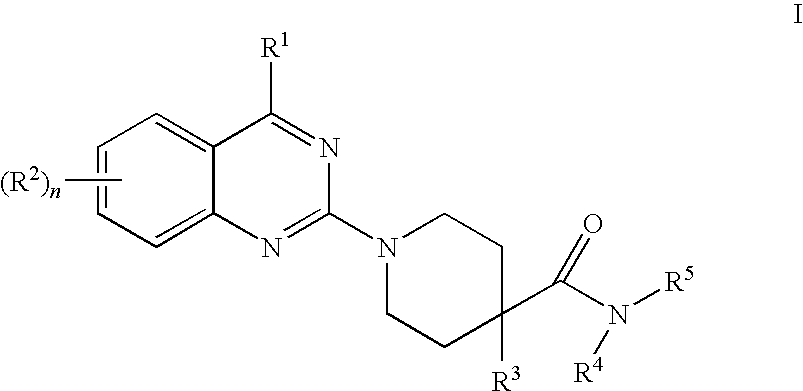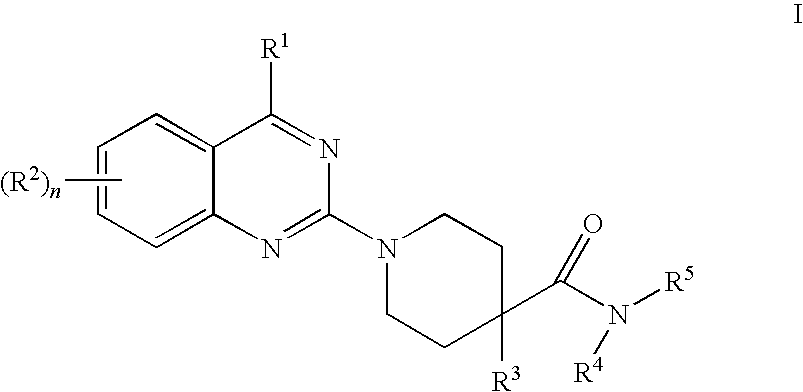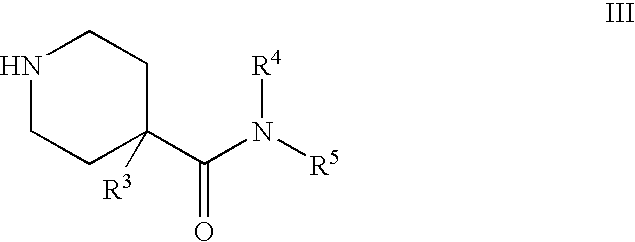Quinazoline derivatives as NK3 receptor antagonists
a technology of nk3 receptor and derivatives, which is applied in the direction of biocide, heterocyclic compound active ingredients, drug compositions, etc., can solve the problems of hampered efforts and lack of knowledge about the cause and nature of this diseas
- Summary
- Abstract
- Description
- Claims
- Application Information
AI Technical Summary
Problems solved by technology
Method used
Image
Examples
example 1
1-(4-Amino-6,7-dimethoxy-quinazolin-2-yl)-4-benzyl-piperidine-4-carboxylic acid (pyridin-3-ylmethyl)-amide
[0132]
[0133]A mixture of 12 mg (0.05 mmol) 4-amino-2-chloro-6,7-dimethoxyquinazoline (commercially available), 28.6 mg (0.074 mmol) 4-benzyl-piperidine-4-carboxylic acid (pyridin-3-ylmethyl)-amide; dihydrochloride (intermediate 1) and 32 mg (0.25 mmol) DIPEA in 0.8 mL dimethylacetamide was heated in a microwave oven for 20 min to 190° C. The mixture was subjected to purification by preparative HPLC on reversed phase eluting with a gradient formed from acetonitrile, water and acetic acid to yield after evaporation of the product fractions 5.7 mg (21%) of the title compound as light brown solid. MS (m / e): 513.4 (MH+).
[0134]In analogy to the procedure described for the synthesis of 1-(4-Amino-6,7-dimethoxy-quinazolin-2-yl)-4-benzyl-piperidine-4-carboxylic acid (pyridin-3-ylmethyl)-amide (example 1) further quinazoline derivatives have been synthesized from their respective starting...
example 18
1-(4-Amino-6,7-dimethoxy-quinazolin-2-yl)-4-benzyl-piperidine-4-carboxylic acid ((S)-1-phenyl-propyl)-amide
[0136]
a) Step 1
1-(4-Amino-6,7-dimethoxy-quinazolin-2-yl)-4-benzyl-piperidine-4-carboxylic acid
[0137]
[0138]A mixture of 2 g (8.3 mmol) 4-amino-2-chloro-6,7-dimethoxyquinazoline, 2.37 g (9.6 mmol) 4-(Ethoxycarbonyl)-4-phenylpiperidine and 7.2 mL (42 mmol) DIPEA in 50 mL N,N-dimethylacetamide was heated in a microwave oven for 45 min to 190° C. The mixture was evaporated to dryness taken up on isolute and subjected to purification by column chromatography on silica eluting with a gradient formed from DCM, methanol and 2N NH3 to yield after evaporation the intermediate ester. The residue was taken up in 50 mL ethanol and 10 mL 4N NaOH and warmed to reflux for 52 h. Water and ethyl acetate was added after evaporation of ethanol and the vigorously stirred mixture was adjusted to pH 4-5 with acetic acid. The precipitate was filtered off, washed with water and methanol and dried under ...
example 81
4-Benzyl-1-(4-hydroxy-6-trifluoromethoxy-quinazolin-2-yl)-piperidine-4-carboxylic acid benzylamide
[0164]
[0165]A mixture of 26.6 mg (0.15 mmol) 4-trifluoromethoxy-phenylamine (commercially available) and 21.6 mg (0.165 mmol) ethyl isocyanatoformate in 3 mL DCM was stirred at room temperature overnight. A mixture of 53 mg (0.172 mmol) 4-benzyl-piperidine-4-carboxylic acid benzylamide (commercially available), 45 mg (0.45 mmol) NEt3 and 34 mg (0.18 mmol) EDCI in DCM was added and the solution was stirred at room temperature. The mixture was absorbed on isolute and purified by flash column chromatography on silica eluting with a gradient formed from DCM, methanol and ammonia (2N). The product containing fractions were evaporated to dryness and taken up in 2 mL DMF. 163.9 mg (1.5 mmol) trimethylchlorosilane was added and the mixture was heated to 85° C. overnight. The mixture was subjected to purification by preparative HPLC on reversed phase eluting with a gradient formed from acetonitr...
PUM
| Property | Measurement | Unit |
|---|---|---|
| volume | aaaaa | aaaaa |
| pH | aaaaa | aaaaa |
| multireceptor affinity | aaaaa | aaaaa |
Abstract
Description
Claims
Application Information
 Login to View More
Login to View More - R&D
- Intellectual Property
- Life Sciences
- Materials
- Tech Scout
- Unparalleled Data Quality
- Higher Quality Content
- 60% Fewer Hallucinations
Browse by: Latest US Patents, China's latest patents, Technical Efficacy Thesaurus, Application Domain, Technology Topic, Popular Technical Reports.
© 2025 PatSnap. All rights reserved.Legal|Privacy policy|Modern Slavery Act Transparency Statement|Sitemap|About US| Contact US: help@patsnap.com



